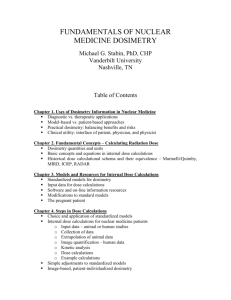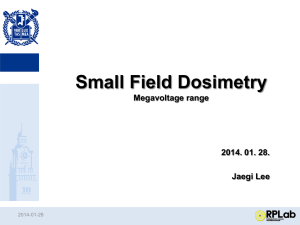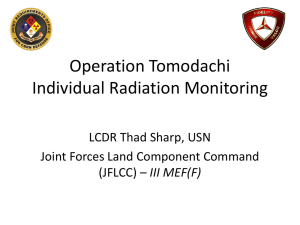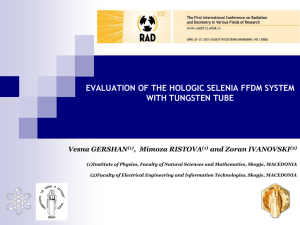Harmonization of Individual Dosimetry Quality Control Within
advertisement
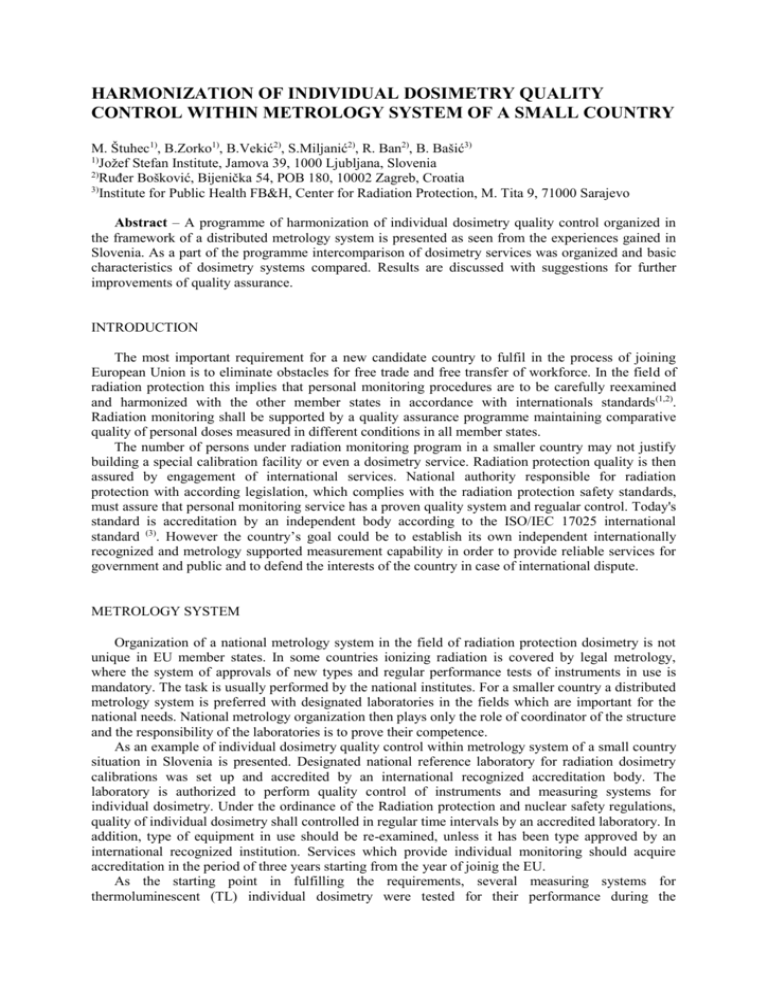
HARMONIZATION OF INDIVIDUAL DOSIMETRY QUALITY CONTROL WITHIN METROLOGY SYSTEM OF A SMALL COUNTRY M. Štuhec1), B.Zorko1), B.Vekić2), S.Miljanić2), R. Ban2), B. Bašić3) 1) Jožef Stefan Institute, Jamova 39, 1000 Ljubljana, Slovenia 2) Ruđer Bošković, Bijenička 54, POB 180, 10002 Zagreb, Croatia 3) Institute for Public Health FB&H, Center for Radiation Protection, M. Tita 9, 71000 Sarajevo Abstract – A programme of harmonization of individual dosimetry quality control organized in the framework of a distributed metrology system is presented as seen from the experiences gained in Slovenia. As a part of the programme intercomparison of dosimetry services was organized and basic characteristics of dosimetry systems compared. Results are discussed with suggestions for further improvements of quality assurance. INTRODUCTION The most important requirement for a new candidate country to fulfil in the process of joining European Union is to eliminate obstacles for free trade and free transfer of workforce. In the field of radiation protection this implies that personal monitoring procedures are to be carefully reexamined and harmonized with the other member states in accordance with internationals standards (1,2). Radiation monitoring shall be supported by a quality assurance programme maintaining comparative quality of personal doses measured in different conditions in all member states. The number of persons under radiation monitoring program in a smaller country may not justify building a special calibration facility or even a dosimetry service. Radiation protection quality is then assured by engagement of international services. National authority responsible for radiation protection with according legislation, which complies with the radiation protection safety standards, must assure that personal monitoring service has a proven quality system and regualar control. Today's standard is accreditation by an independent body according to the ISO/IEC 17025 international standard (3). However the country’s goal could be to establish its own independent internationally recognized and metrology supported measurement capability in order to provide reliable services for government and public and to defend the interests of the country in case of international dispute. METROLOGY SYSTEM Organization of a national metrology system in the field of radiation protection dosimetry is not unique in EU member states. In some countries ionizing radiation is covered by legal metrology, where the system of approvals of new types and regular performance tests of instruments in use is mandatory. The task is usually performed by the national institutes. For a smaller country a distributed metrology system is preferred with designated laboratories in the fields which are important for the national needs. National metrology organization then plays only the role of coordinator of the structure and the responsibility of the laboratories is to prove their competence. As an example of individual dosimetry quality control within metrology system of a small country situation in Slovenia is presented. Designated national reference laboratory for radiation dosimetry calibrations was set up and accredited by an international recognized accreditation body. The laboratory is authorized to perform quality control of instruments and measuring systems for individual dosimetry. Under the ordinance of the Radiation protection and nuclear safety regulations, quality of individual dosimetry shall controlled in regular time intervals by an accredited laboratory. In addition, type of equipment in use should be re-examined, unless it has been type approved by an international recognized institution. Services which provide individual monitoring should acquire accreditation in the period of three years starting from the year of joinig the EU. As the starting point in fulfilling the requirements, several measuring systems for thermoluminescent (TL) individual dosimetry were tested for their performance during the intercomparison exercise organized by the National secondary standards dosimetry laboratory. Irradiation conditions were optimized to so called »test before first use« according to the requirements of international guides(4) . A program of periodic testing was then proposed and started as a routine monthly service. INTERCOMPARISON Five dosimetry services were included in the intercomparison exercise, three from Slovenia one from the neighbouring country Croatia and one from Federation of Bosnia and Herzegovina. The services mostly provide personal dosimetry to workers in hospitals and industry. One of the services belongs to the nuclear power plant and covers only its own workers and one service is specialized to personal dosimetry of workers at research institutes, such as oncology, research nuclear reactor, X-ray facilities etc. The most common TL material in use is lithium fluoride, used in three of the services. The other two services were participating with dosemeters based on combination of lithium borate and calcium sulphate and energy compensated calcium fluoride. Irradiation conditions Irradiations were performed in the Laboratory for dosimetry standards at Jožef Stefan Institute, which is accredited and traceable to the international primary standards. Different irradiation conditions were prepared in accordance with the ISO 4037 standard(5). They were chosen to test energy dependence, directional dependence and response to a mixed field. Irradiation qualities and Hp(10) doses used in the irradiations are shown in Table 1. Selection of energies included X-rays with narrow spectra N40-N150 in the range of anode voltages from 40 kV up to 150 kV and 0,662 MeV 137 Cs source. In one of the irradiation condition mixed field was used, where the Hp(10) dose was added up with 40% of N-100 and 60% of 137Cs component. The use of special irradiation condition was motivated by the results of workplace field examinations(6). In-situ gamma spectrometry showed that also in the field of high energy source as 137Cs low energies around 100 keV make considerate contribution due to scattering. Measurements of directional distribution of different workplace fields on the other hand showed that workers are usually exposed from different directions than expected from direct irradiation. Each participating TLD service provided 40 dosemeters for irradiations, usually used in regular service for personal monitoring. Groups of five dosemeters were irradiated at each quality on the ISO slab phantom(7). One group was left unirradiated to measure the reference backgrounddose, which was later subtracted during the evaluation. Table 1. Irradiation conditions. Nº Radiation quality 1 2 3 4 5 6 N-40 N-60/0º N-60/60º N-100 N-100 + 137Cs N-150 7 137 Cs Hp(10) (mSv/h) 1.05 2.13 1.64 1.38 1.69 4.68 1.25 Results The results of the intercomparison of all five services at all seven irradiation qualities are shown on Figure 1. They are expressed as relative responses R=Dm/Dt, the ratios of measured to conventional true values of Hp(10) doses. Average values of five dosemeters are reported for each irradiation condition. It is clear that all results are in the range of so called “trumpet curve”(8), with the responses within the required interval from 0,5 to 1,7. 1.6 R 1.3 1.0 0.7 1.1 1.2 1.3 1.4 1.5 1.6 1.7 2.1 2.2 2.3 2.4 2.5 2.6 2.7 3.1 3.2 3.3 3.4 3.5 3.6 3.7 4.1 4.2 4.3 4.4 4.5 4.6 4.7 5.1 5.2 5.3 5.4 5.5 5.6 5.7 0.4 Laboratory.radiation quality Figure1. Summary of all intercomparison results. Responses R are expressed as ratios of measured to conventional true values of Hp(10). In the next step of evaluation the results for separate irradiation conditions were analyzed in more details. Comparison of doses resulted from irradiation with the standard reference source 137Cs (irradiation quality 7 on figure 1)showed that calibration factors of all but one measuring system were within 6% of conventional true value. If calibration of the outlier service, which deviated for about 15 % is corrected, it turned out that its energy and directional dependence results were equal to the service using the same type of measuring system and consistent with the TL material used (9). 20 10 R-1 0 -10 -20 -30 -40 33 48 83 118 662 Mean photon energy (keV) Figure 2. Energy dependence of energy compensated TLD systems A (diamonds) and B(squares). R - ratios of measured to conventional true values of Hp(10). In Figure 2 energy dependence is shown for two of the systems, which use energy compensation with the use of combination of different types of TL sensors (A) and different filters (B). According to the IEC 1066 standard requirements(10) deviation of the relative response R=Dm/Dt from 1 should not exceed ±30% in the range of energies from 33 to 662 keV. Error bars of the measured values shown on the figure indicate the expanded measurement uncertainties with 95% confidence interval. The uncertainties include standard deviations of the means of five dosemeter's readings and uncertainty of the conventional true values. The results for the two systems with no energy compensation C and D are shown in Figure 3. 60 50 40 R-1 30 20 10 0 -10 -20 33 48 83 118 662 Mean photon energy (keV) Figure 3. Energy dependence of two TLD systems with no energy compensation C (diamonds) and D(squares). R - ratio of measured to conventional true values of Hp(10). Table 2. Directional dependence and response to a mixed field. Service Nº 1 2 3 4 5 R60º/R0º - 1 (%) 15 11 13 12 12 Dm/Dt (%) -22 -4 9 -19 -19 The results of directional dependence and response to the N-100 + 137Cs mixed field are shown in Table 2. The IEC 1066 standard(10) allows at most 15% deviation of measured dose at inclined irradiation compared to the direct irradiation, where angles of incidence are 20º, 30º and 60º in the field of 60 keV X-rays.The responses for 0ºand 60º angles of incidence at the 60 kV X-rays irradiations were compared in the intercomparison. The results for 60º irradiation deviations R60º/R0º - 1 are about 12 % for all but one of the (energy compensated) measuring systems, for which the result with 15% deviation lies on the edge of the standard requirements. It is interesting to note that irradiations in mixed fields gave rather good results where the measured values from for all but one of the systems underestimated conventional true doses by about 20%. One of the services, which uses energy noncompensating dosemeters overestimated the true dose by about 10%. Satisfying results for the mixed field can be explained with the good energy response of all the measuring systems for the chosen combination of the irradiation qualities. CONCLUSIONS As initial stage of QC programme for individual dosimetry within a distributed metrology system intercomparison of 5 TLD services was performed. Resuls showed good overall performance regarding so called “trumpet curve” requirements. Some discrepancies were found concerning calibration traceability of one TLD system and energy dependence of two systems, and the services were advised to search for technical improvements. The exercise resulted also good angular dependence and response to a mixed field. At conclusion regular QC is suggested in order to maintain stability of the system’s performances. REFERENCES 1. International Atomic Energy Agency (IAEA). International Basic Safety Standards for Protection against Ionizing Radiation and for the Safety of Radiation Sources. Safety Series No. 115 (Vienna: IAEA) (1996). 2. European Commission. Council Directive 96/29/Euratom, of 13 May 1996, laying down Basic Safety Standards for the Protection of the Health of Workers and General Public Against the Dangers Arising from Ionizing Radiation. Official Journal of the European Communities L 159, vol. 39 (29 June 1996). 3. International Organisation for Standardisation, General Requirements for the Competence of Testing and Calibration Laboratories ISO/IEC 17025 (Geneva: ISO/IEC) (1999). 4. Scott, C., Burgess, P., and Woods, M. The Examination, Testing and Calibration of Portable Radiation Protection Instruments. Measurement Good Practise Guide 14. Teddington: NPL; March 1999. 5. International Organisation for Standardisation, X and Gamma Reference Radiation for Calibrating Dosemeters and Doserate Meters and for Determining Their Response As A Function Of Photon Energy. ISO 4037 (Geneva: ISO) (1999). 6. d’Errico, F., Bartlett, D. T., Ambrosi, P. and Burgess, P. Determination of direction and energy distributions. Radiat. Prot. Dosim. 107(1-3), 133-153 (2003). 7. Alberts, W. G., Ambrosi, P., Boem, J., Dietze, G., Hohlfeld, K. and Will,, W.. New dose quantities in radiation protection. PTB-Bericht PTB-Dos-23e. Braunschweig: PTB; August 1996. 8. International Organisation for Standardisation, Criteria for a Periodic Assessment of the Enabled Organizations for Individual X and Gamma Dsimetry and determination of the Performance Limits of Dosimetry Systems ISO 14146 (Geneva: ISO) (1999). 9. Miljanić, S., Knežević, Ž., Štuhec, M., Ranogajec-Komor, M., Krpan, K. and Vekić, B. Energy dependence of new thermoluminiscent detectors in terms of Hp(10) values. Radiat Prot Dosim. 100(1-4),253-256 (2002). 10. International Organisation for Standardisation, Thermoluminiscence Dosimetry Systems for Personal and Environmental Monitoring. IEC 1066 (Geneva: IEC) (1996).


